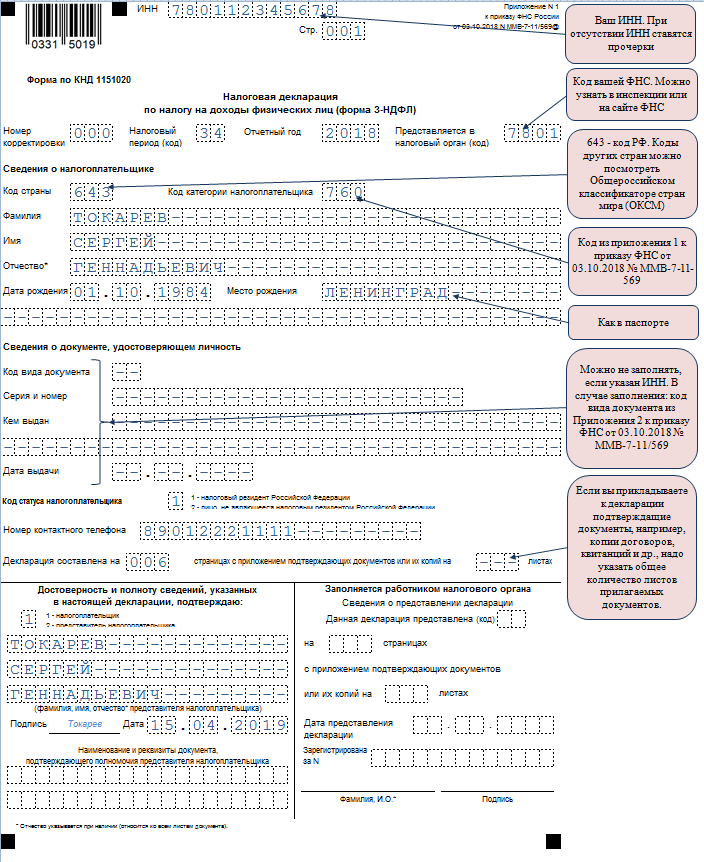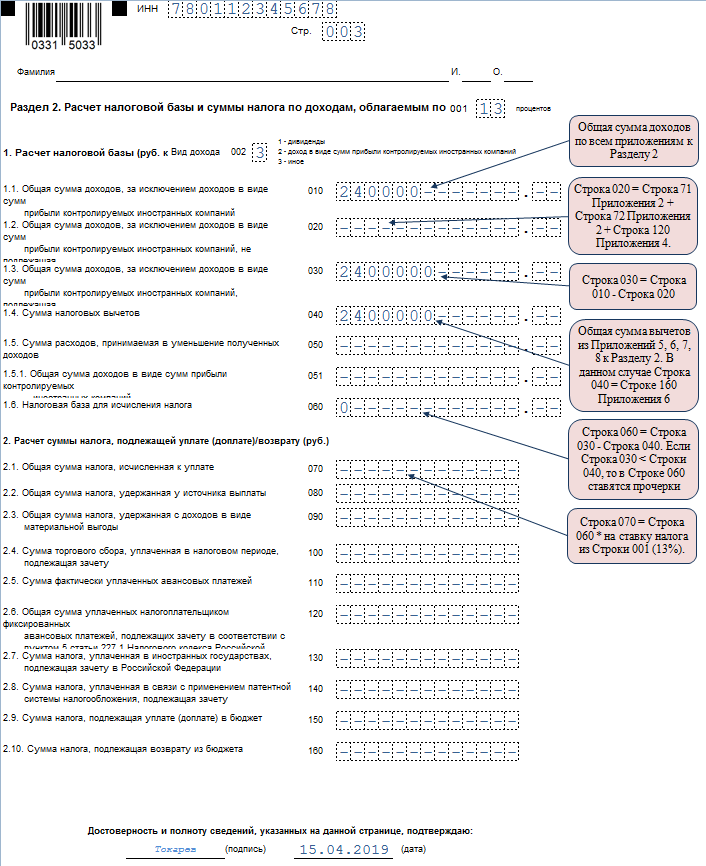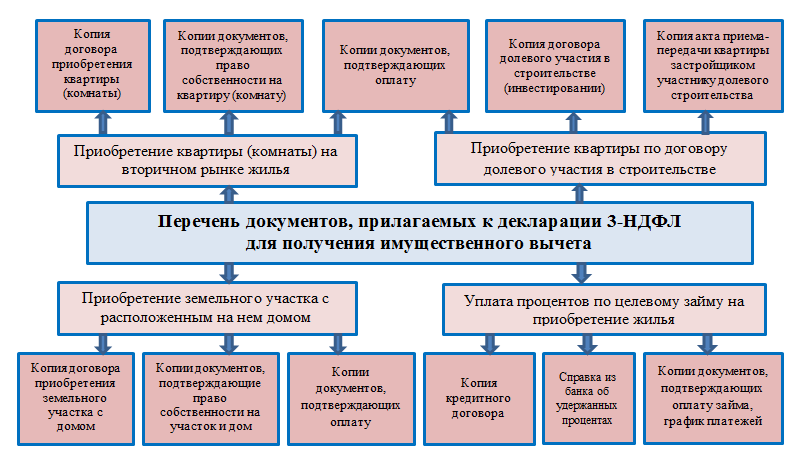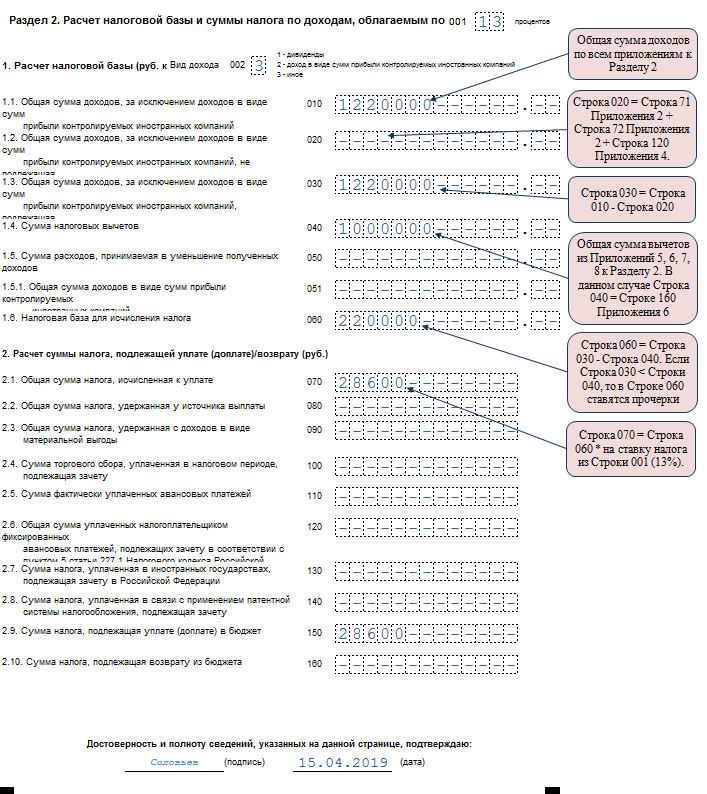Filling out the declaration 3-NDFL for property deduction
Filling out the 3-NDFL declaration for a property deduction differs from the scheme for filing declarations when receiving other tax deductions. Learn from our material the algorithm for filing a declaration and the formula for calculating personal income tax, as well as an example of filling out a 3-personal income tax declaration to receive a property deduction.
Who and when can apply for a property deduction
A property deduction is an opportunity for a taxpayer to:
- return a part of the personal income tax previously transferred to the budget;
- not pay tax at all or reduce its size.
A person who has committed certain manipulations with personal property can receive a property deduction, such as:
- sale of property;
- buying a home;
- acquisition of land for the construction of housing and (or) the implementation of this construction;
- conclusion of a property purchase agreement for state or municipal needs.
A person can count on a property deduction:
- having legal sources of income subject to personal income tax at a rate of 13%;
- is the owner of the property (bought or sold);
- who paid for the acquired housing at the expense of their own or borrowed money;
- who filled out and sent the 3-NDFL declaration to the tax authorities (with supporting papers and an application for a tax refund attached to it).
The following sections will reveal the subtleties and nuances of filling out 3-personal income tax and calculating tax in a situation where a property deduction is received.
IMPORTANT! The declaration for 2018 must be submitted in a new form from the order of the Federal Tax Service dated 03.10.2018 No. ММВ-7-11 / [email protected] You can download the form.
On our forum, you can consult on any issue that you have when filling out the 3-personal income tax declaration. For example, we share our experience on how to independently fill out a 3-personal income tax declaration for treatment.
Sale of property and 3-personal income tax (example of filling out)
The need to file a 3-NDFL declaration appears for an individual if he:
- received income from the sale of his property;
- owned the sold property less than that established in Art. 217.1 and paragraph 17.1 of Art. 217 of the Tax Code of the Russian Federation MSVI (minimum period of ownership of property).
The Tax Code provides for 2 types of property deduction when selling property:
- 1 million rubles (when selling real estate);
- 250 000 rub. (when selling other property).
Registration of the declaration 3-NDFL:
- mandatory if the term of ownership of the property was less than the MSVI (regardless of the amount of income received from its sale);
- not required if more than the MSVI passed from the beginning of ownership of the property to its sale (clause 17.1 of article 217, subparagraph 2 of clause 1 of article 228, clause 4 of article 229 of the Tax Code of the Russian Federation).
The features of the definition of MSVI are shown in the diagram:
To figure out whether to issue 3-personal income tax or not, examples will help.
Example 1
Tumanov A. A. purchased an apartment in 2013. In 2019, he sold it for 5,243,000 rubles. Deadlines:
- acquisitions — until 01/01/2016;
- ownership - more than 3 years.
Conclusion: Tumanov A.A. does not need to file 3-personal income tax and pay personal income tax.
Example 2
Sidorova G. E. in September 2018 sold an apartment privatized in December 2015 for 3,200,000 rubles.
Deadlines:
- acquisition of ownership — until 01/01/2016;
- ownership - less than 3 years.
Conclusion: Sidorova G.E. needs to file 3-personal income tax and pay tax.
Example 3
Tokarev S. G. purchased a car in December 2017, which he sold in September 2018 for 240,000 rubles.
Calculation of terms: the car was owned for 10 months. (less than 3 years).
How Tokarev S. G. fill out 3-personal income tax, we will tell in the next section.
Filling out 3-personal income tax when selling a car
We use the data from example 3 of the previous section to fill out the 3-NDFL declaration with a property deduction.
Example 3 (continued).
Tokarev S. G. studied the structure of 3-NDFL and came to the conclusion that he would need to fill out the following declaration sheets:
- title page;
- section 1;
- section 2;
- Attachment 1;
- application 6.
Step 1. Tokarev began filling out the declaration from the title page. Here he indicated the number of the adjustment (for the primary declaration - 0), full name, data on the date and place of birth, citizenship and passport of Tokarev S. G. and other required information in the fields proposed for filling.

For further data entry, Tokarev S. G. used information about the car buyer from the sales contract:
- Entered information about the source of income payment in page 060 - the buyer of the vehicle. Since the buyer is an individual, Tokarev S. G. indicated only his full name.
- Income information:
- in line 020, the value 03 is the income code, which means the sale of other property;
- in line 070 - 240,000 - the amount received from the sale of the vehicle.

Step 4. In this step, Tokarev filled out section 2, indicating on page 010 the amount received for the car, and on page 040 the amount of the property deduction.

Step 5. Since the amount of tax payable is zero, in section 1 Tokarev indicated the value 0 on p. 050, and on p. 020 and 030 of the KBK and OKTMO.

What documents are needed for property deduction
For Tokarev S. G. from the considered example, the list of documents attached to 3-NDFL for obtaining a property deduction consists of 3 items:
- a copy of the passport (pages with personal data and registration);
- a copy of the contract of sale of the car;
- copies of payment documents.
When an individual claims to receive a property deduction when buying real estate, the list of documents for the 3-NDFL declaration will differ depending on the type of property and the form of its acquisition (see the diagram for an example):

The taxpayer may need an additional document - a special notification from the tax authorities confirming the right of an individual to a property deduction (the notification form was approved by order of the Federal Tax Service of Russia dated 14.01.2015 No. ММВ-7-11 / [email protected]), if:
- expenses incurred for the purchase or new construction of real estate (including the payment of interest on the repayment of targeted loans) - a property deduction for such situations is provided for in subpara. 3-4 p. 1 art. 220 of the Tax Code of the Russian Federation;
- an individual intends to receive a property deduction at their place of work (clause 8, article 220 of the Tax Code of the Russian Federation).
To receive a notification, you must contact the inspectorate at the place of residence with an application and supporting documents.
What documents will be needed to receive a notification, from what month and in what amount the property deduction will be provided at the place of work of the taxpayer, see.
Formulas for calculating personal income tax when buying and selling property
Calculation of personal income tax when buying property
When buying real estate, the taxpayer can return part of the personal income tax from the budget. The standard formulas for calculating the tax refunded from the budget (personal income tax return) are as follows:
1. Property acquired without borrowing:
Personal income tax return = PH × 13%, if PH ≤ 2 million rubles,
personal income tax return = 2,000,000 rubles. × 13% \u003d 260,000 rubles, if pH > 2 million rubles,
where РН is the taxpayer's expenses for new construction or purchase of housing;
2 million rubles - the maximum property deduction when acquiring property.
2. A targeted loan (credit) was used to purchase real estate:
Personal income tax % = RP × 13%, if RP ≤ 3 million rubles,
personal income tax % = 3,000,000 rubles. × 13% = 390,000 rubles, RP > 3 million rubles,
where personal income tax % is the amount of personal income tax returned upon payment of interest on the target loan (credit);
RP - expenses on interest paid;
3 million rubles - the maximum property interest deduction (if the target loan was received before 2014, the property interest deduction is not legally limited by the upper limit).
3. Real estate is partially paid for by maternity capital:
Personal income tax return = (RN - MK) × 13%, if (RN - MK) ≤ 2 million rubles,
personal income tax return = 2,000,000 rubles. × 13% \u003d 260,000 rubles, if (RN - MK) > 2 million rubles,
where MK is the maternity capital funds spent on the purchase of real estate.
A similar formula is used to calculate the tax if the property is paid for with funds:
- employers;
- budget;
- other persons.
4. Real estate was purchased from related parties - in this situation, it will not be possible to return personal income tax, regardless of the value of real estate, since in this situation the taxpayer has no right to a property deduction. The following persons are recognized as interdependent with the taxpayer (Article 105.1 of the Tax Code of the Russian Federation):
- his parents (adoptive parents);
- his children (including adopted children);
- his spouse (wife);
- his brothers and sisters;
- his guardian (custodian) and ward.
Calculation of personal income tax when selling property
Personal income tax payable (personal income tax upl) is determined by the following formulas:
1. Income received from the sale of land plots, residential buildings, apartments, rooms, garden houses, summer cottages, as well as shares in the said property:
Personal income tax upl \u003d (CIT - 1,000,000 rubles) × 13%, if CIT > 1 million rubles,
Personal income tax upl = 0, if DPT ≤ 1 million rubles,
where DPN - income from the sale of real estate;
1 million rubles - the maximum property deduction allowed by the Tax Code of the Russian Federation when selling real estate.
Example 1
Solovyov A.P. sold an apartment in 2018 for 1,220,000 rubles. In the 3-NDFL declaration, he reflected an income in the amount of 1,220,000 rubles. and a property deduction in the amount of 1 million rubles. Personal income tax payable was calculated by the formula:
Personal income tax upl \u003d (1,220,000 rubles - 1,000,000 rubles) × 13% \u003d 28,600 rubles.

Example 2
Vasilyeva T.N. in 2018 received 643,000 rubles from the buyer. under a contract for the sale of a cottage. She filed a 3-NDFL declaration, indicating the income received (643,000 rubles) and a property deduction in the same amount. She will not have to pay personal income tax from this transaction (643,000 rubles ≤ 1 million rubles).
2. Income received from the sale of other property (car, garage or other items):
Personal income tax upl \u003d (DPI - 250,000 rubles) × 13%, if DPI > 250,000 rubles,
personal income tax upl = 0 if DPI ≤ 250,000 rubles,
where DPI - income from the sale of other property;
250 000 rub. - the maximum property deduction allowed by the Tax Code of the Russian Federation when selling other property.
Example 3
Two brothers, Stepan and Andrey Tumanov, decided to update their cars in 2018. Before buying new cars, they sold their old cars:
- for 523,000 rubles. (Stepan),
- RUB 182,000 (Andrew).
When calculating personal income tax payable, they used the following formulas: The second year of application of the property deduction: repeated declaration of 3-NDFL
The situation when the property deduction can be applied for several years is typical for real estate purchase situations. For example, if the amount of personal income tax withheld from the taxpayer's income (taxable with personal income tax 13%) for the period of filing 3-personal income tax is less than 260,000 rubles, the right to the balance of the unused deduction does not expire, but is transferred to subsequent periods.
Example
The stamper Lakhtina E. B. in 2017 bought an apartment on the secondary housing market for 1,760,000 rubles. For the specified period, personal income tax = 81,120 rubles was transferred from her salary to the budget. The amount of personal income tax to be returned from the budget:
- calculated from the purchase price: 1,760,000 rubles. × 13% = 228,800 rubles;
- possible to return (for 2015): 81,120 rubles.
The balance of personal income tax, which can be returned from the budget in subsequent periods: 228,800 - 81,120 \u003d 147,680 rubles.
In 2018, E. B. Lakhtina got an additional job in another company part-time. At the end of 2018, the personal income tax transferred to the budget from the salary she received from 2 employers amounted to 127,000 rubles. - Lakhtina E. B. can return this amount from the budget by again submitting 3-NDFL and other required documents to the inspection (certificate 2-NDFL for 2018, application for a return of personal income tax, documents confirming the purchase of housing).
The balance of the deduction in the amount of 20,680 rubles. (147,680 - 127,000) Lakhtina E. B. will return at the end of 2019 if she again submits the necessary documents to the tax office.
Results
The use of a property deduction allows you to return personal income tax from the budget (when buying real estate) or reduce income tax payable (when selling property).
When filling out the 3-NDFL declaration for a property deduction, an individual needs to take into account many nuances (the period of ownership of property, the maximum allowable deduction, etc.), as well as collect a package of supporting documents (2-NDFL certificates, a real estate purchase and sale agreement, an act of acceptance and transfer completed housing construction, etc.).




